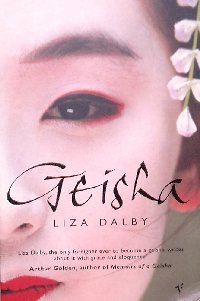

Mineko Iwasaki was the former geisha who provided a great deal of the information used by Arthur Golden's more famous, "Memoirs of a Geisha". Following a somewhat bitter dispute between Iwasaki and Golden, Iwasaki decided to publish her own memoirs, "Geisha of Gion" or "Geisha: A Life" (as it is titled in North America) to help clarify certain matters that she felt Golden had misinterpreted.
According to an interview she gave the Boston Phoenix, she said her reasons for publishing her memoirs were:
"...there was a lot of misunderstandings about what it means to be a geiko or a geisha The most common misconception is that geisha are somehow high-class courtesans, or prostitutes. And that is very much not the case. And also, geisha are not submissive and subservient, but in fact they are some of the most financially and emotionally successful and strongest women in Japan, and traditionally have been so..."
The book itself, while it lacks Arthur Golden's stunning prose and evocative descriptions still manages to take the reader into an antiquated world that is so exotic, so unlike anything we've been exposed to before that I literally had to remember to close my jaw just in case people thought I was a fool! After all, Geishas have a strict code of secrecy which is the reason why so little is known about them, and to suddenly have all this revealed to us, is like discovering a brand new world!
Mineko Iwasaki came from an aristocratic family who had fallen on hard times. Her parents decided that the only way they could give their daughters a better life would be to have them join a "karyuki" (Geisha House) in Kyoto where they would be fed, clothed, schooled and trained in a profession that would allow them to lead lives that would ensure they were financially independent of any man. This book follows Mineko's life from the time she joined the "Geisha House" at the tender age of five till she left as the unrivalled Queen of Geishas.
 |
"...After becoming a Maiko (novice Geisha), I had my hair donw once every five days. To preserve its shape, I slept on a rectangular lacquered wooden pillow topped with a narrow cushion. At first the pillow kept me awake but I soon got used to it. Other girls found it more difficult. The okiya (geisha household) had a trick tp keep us from removing the pillow during the night. The maids would sprinkle rice bran around the pillow. If a girl removed the pillow, bits of bran stuck like glue to the pomade in her hair and the next morning she had to make an unhappy trip back to the hairdresser's..." pg 158
In Mineko's case, not only does she have to put up with all of the physical inconveniences, but because she was adopted into the Iwasaki Geisha family, she had to renounce her parents in a court of law. It was a very difficult choice for her but something that she had to do. She also had incurred the wrath and jealousies of all the other geishas she worked with because she was one of the most popular geishas of her time.
Her book tells of all the famous people she had to entertain in her role as a Geisha, including, Prince Charles, Queen Elizabeth and Prince Phillip, Alberto Gucci among others. She describes an incident where Prince Charles asks to see her fan and when she gives it to him for closer inspection he takes a pen and scrawls his signature over it expecting her to be pleased. She is completely devastated that he would ruin her favorite fan and instructs a servant to dispose of it as soon as the event is over.
Mineko grew increasingly wary of her punishing schedule, the politics of the okaya and it's social and financial restrictions, she was itching to have her own life and to be her own person, so, at the grand old age of 29 she decided that she would retire and leave the life of a Geisha behind.
 |
This is an enjoyable read indeed! Included within the book are two lots of personal photos of Mineko, her family and some of the Geishasshe worked with. I wish she had more pictures of her amazing kimonos which she has described in such vivid detail throughout the book. I also wish the editors had included a glossary. There are so many Japanese terms used in the book and while they are explained in English when they are first introduced, one tends to forget what they mean as you delve deeper into thememoir. A glossary to refer to from time to time would have been very useful.
Although this book is sufficient unto itself with its long,detailed descriptions of the world of a Geisha, a supberb handbook would be Lisa Dalby's "Geisha".
 |
Both Liza Dalby and Mineko Iwasaki believe that the golden age of the Geisha is over and that there are not enough truly wealthy individuals in Japanese society with the leisure and the means to support the ' flower and the willow'. Iwasaki is particularly despondant and believes that the traditional culture of the "Geisha Houses" will cease to exist in the future.
Furthur Reading:
Photo Journal of a Geisha (Not Mineko)
Geishas of Japan: A Snapshot
